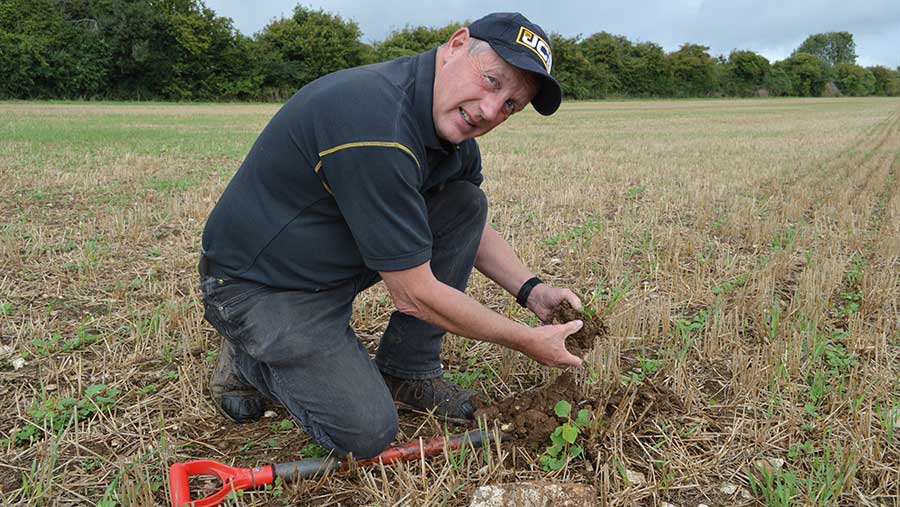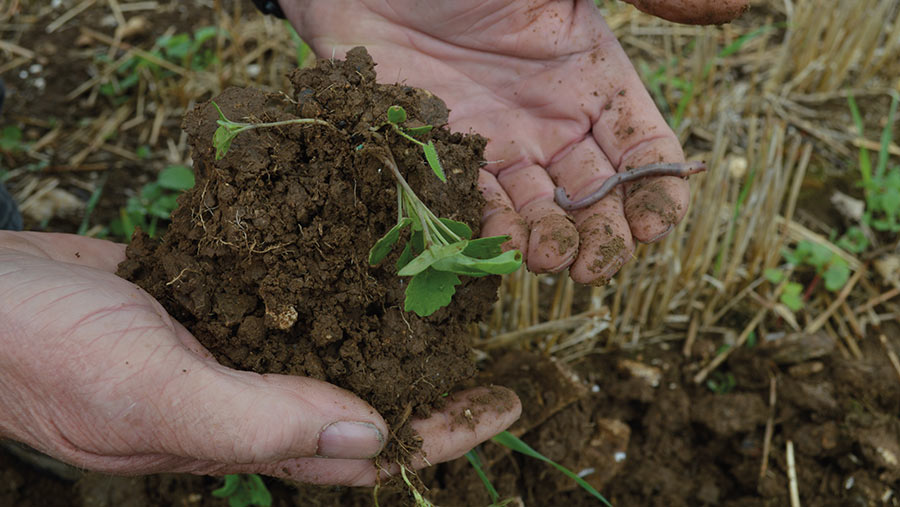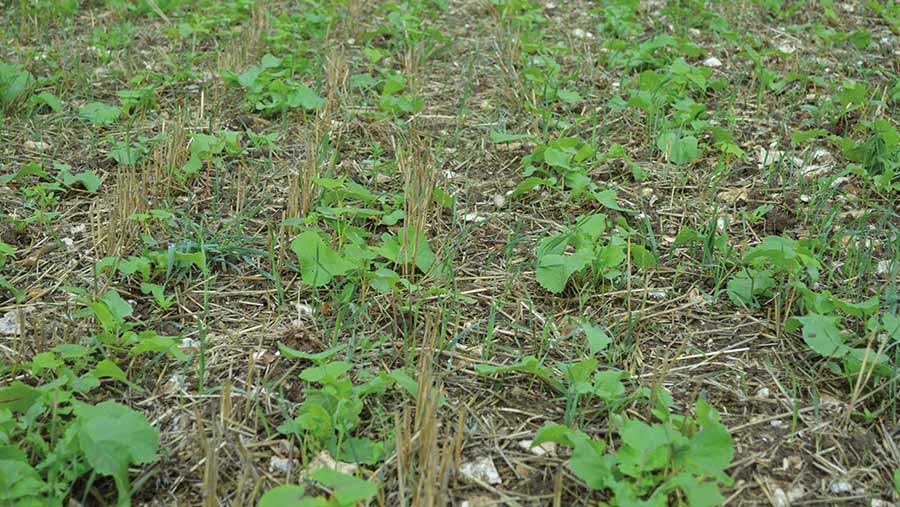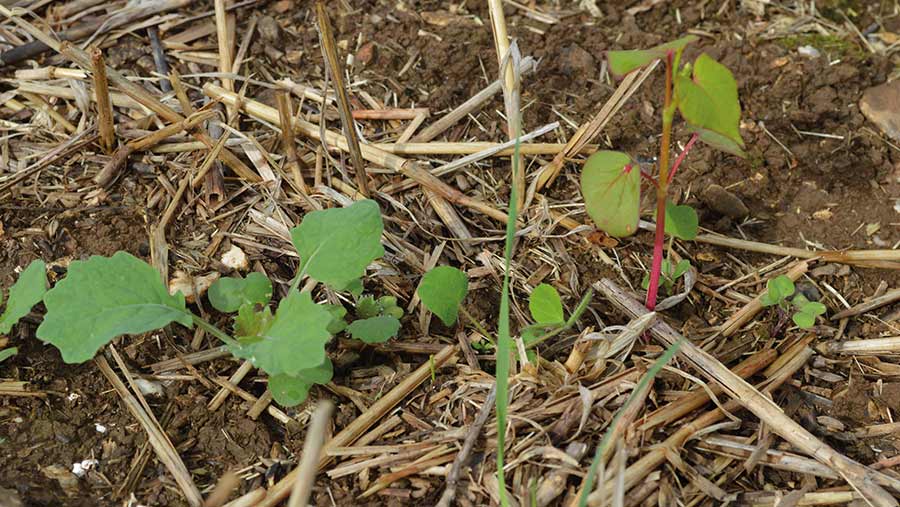How Hampshire grower became Soil Farmer of the Year
 © MAG/David Jones
© MAG/David Jones David Miller became arable Soil Farmer of the Year this summer by growing a combination of catch, cover and companion crops to create more biologically active soils, and the resultant healthier plants allow him to cut back on expensive inputs.
His intense focus on soils at his Hampshire farming operation came some 12 years ago when his journey toward regenerative farming began as he saw yields plateauing and only likely to rise with ever-increasing amount of inputs from the chemical can or fertiliser sack.
He jointly won the Soil Farmer of the Year award in June due to his innovative regenerative farming approach without any sight of livestock or whiff of manure on the chalky light land he farms, and yet soil organic matter is on the increase.
“We wanted to prove that our system could work on any broad-acre farm. The aim is to increase the margin rather than the yield, as healthy plants allow us the option to reduce inputs,” he tells Farmers Weekly.
See also: Hants and Hereford growers named 2022 Soil Farmers of the Year
Input costs fall

© MAG/David Jones
His philosophy is to build up his soils by increasing organic matter, encouraging mycorrhizal fungi and improving the soil’s biology, and now with the soils in good health, input costs have tumbled. Fuel use has fallen 40% and nitrogen fertiliser use 15% in the past dozen years.
“We have ignored the soil for 40 years and have looked to chemicals to solve problems. We only have ever looked to solve problems and not the causes of the problems,” he says.
Yields on his light chalky land have been largely maintained after his regenerative move, with winter wheats averaging 9t/ha and oilseed rape 3.75t/ha, both with only 180kg/ha of nitrogen applied and total variable input costs for his rapeseed cut to the bone at £300/ha.
There have also been big environmental gains: 13 species of birds on the Royal Society for the Protection of Birds red endangered list have been spotted on the farmland. More active soils have encouraged more worms; and predators such as beetles and spiders are on the rise, hoovering-up potentially damaging slug eggs.
The 4m margins around all fields encourage invertebrates and small mammals, which in turn have encouraged a higher number of predatory owls across the land.
Farming operation
Mr Miller farms 700ha of largely lightly loam arable soils over chalk, with plenty of flints and some clay caps, for four landowners. He is farm manager for Wheatsheaf Farming, based at Folly Farm, North Waltham, just south-west of Basingstoke, with land on both side of the M3 motorway.
Mr Miller is the only full-time member of staff, and the simple arable system he has developed relies largely on just one JCB Fastrac tractor, a self-propelled sprayer, a Horizon disc drill and a combine, and he undertakes about 75% of the work, with contractors and temporary staff brought in at busy times.
He was a previous Farmers Weekly Arable Farmer of the Year in 2015, and is the AHDB’s current Strategic Farm South for the six-year period 2021-27.
The farmland he manages follows the first four of the five principles of regenerative farming: don’t disturb the soil; keep the soil surface covered; keep living roots in the soil; and grow a diverse range of crops; but he has not implement the fifth – bring grazing animals back to the land.
He admits that introducing livestock to the farm would have moved him faster along the route towards regenerative farming, but he is insistent on keeping his system simple, with low labour and machinery costs and the farm profitable.
Yield plateau

© MAG/David Jones
With yields plateauing by 2010, he decided to introduce cover crops to improve soil fertility and it soon become obvious that a no-till regime was the next obvious move, and so he purchased a Cross Slot drill in 2015, which did a good job until the farm needed a “step forward”.
He has moved this year to a 6m Horizon DSX disc drill with two seed hoppers and a liquid fertiliser tank, which gives him more flexibility for drilling a variety of cash, catch and cover crops and needs less power to pull than the Cross Slot and is operated with the Fastrac.
His flexible rotation consists of winter crops such as oilseed rape, wheat, spelt wheat and beans, while one-third of the land is down to spring crops such as wheat, barley and beans, which allows the growing of cover crops through the autumn and early winter.
Cover crop mixes
- Early mix for drilling in late July and early August: phacelia, crimson clover, buckwheat, sunflowers, berseem clover, lupins, vetch and beans
- Late mix for drilling in late August: sunflowers, phacelia, buckwheat, Gold of Pleasure, lupins, vetch and beans
He has just drilled 200ha of cover crops this summer and has refined his choice to species that give good growth but not a big biomass, with a focus on those that give a good rooting system, while not looking to spend more than £30/ha on seed.
If he is drilling early in late July and the first half of August, he goes for a more expensive mix including crimson and berseem clovers, and if later, in the second half of August, the focus is on more reliable species such as beans and Gold of Pleasure (see panel above). “The quickest way to improve organic matter is from decaying roots,” he says.
Current organic matter of his soils stands at 4-5%, much higher than 2010, and hopefully still improving. He has applied no potash fertiliser for eight years and no phosphate for the past two years, as he relies on the cover crops to mine for these two key nutrients in the soil.
Companion crops

OSR with buckwheat © MAG/David Jones
This is the fourth year he has used a companion crop mix of buckwheat with crimson and berseem clovers when drilling his oilseed rape, and he has hardly lost any of the crop to cabbage stem flea beetles, while he has not used any insecticides.
He has drilling 120ha of rapeseed this summer, largely with the farm-saved seed of conventional varieties Campus and Aardvark. His philosophy here is to make sure the farm is growing rapeseed cheaply and his farm-saved seed and companion crop seed costs only come to £32/ha, out of the miserly £300/ha spend on total variable inputs.
The companion crop helps the establishment of the oilseed rape by disguising it from flea beetle predators, but companion crops are also a good host for beneficial mycorrhizal fungi since rapeseed is not a good host.
The buckwheat in the companion crop mix is killed by the first frosts, while a late autumn herbicide of propyzamide + aminopyralid (Astrokerb) takes out the clovers. The only other autumn herbicide used is a graminicide, such as propaquizafop (Falcon), to control volunteer cereals.
Catch crops
The bone dry summer made him miss out on catch crops this year, as they need at least six weeks of growth to give an obvious benefit. There was little opportunity to get them drilled and established with no moisture in the soil, while Mr Miller likes to get all his winter wheat drilled relatively early by the end of September.
When he has grown catch crops, he looks for fast-growing species such as buckwheat and phacelia at a seed cost below £20/ha, and although the immediate benefits are difficult to quantify, he is convinced of their long-term term payback. Catch crops work best with the longest gap between two crops, such as harvested winter barley and drilling winter beans.
The benefits from all these cover and catch crops has allow him to cut fertiliser on his winter wheats to a 180kg/ha three-way split of liquid nitrogen, with some good-looking crops last season needing no fungicide in the dry spring and summer weather. This season he is growing Extase and Graham, with a small area of new varieties Dawsum and Champion.
“The disease pressure is less when we apply less nitrogen, and so we are seeing crops with healthier plants,” he says.
Some areas of the farmland are in Countryside Stewardship, with the SW6 winter cover crops option used, with 24ha of AB15 two-year sown legume fallow and 8ha of AB9 wild bird mixes grown across the farm.
Soil farmers of the year
David Miller and mixed Herefordshire farmer Billy Lewis were the joint winners of the 2022 Soil Farmer of the Year award, which was announced at the Groundswell 2022 event in Hertfordshire during June. The runner-up was Pembrokeshire dairy farmer Andrew Rees.
The award is in its seventh year and is organised by the Farm Carbon Toolkit and Innovation for Agriculture – a consortium of English agricultural societies – and is sponsored by agronomy group Hutchinsons and Cotswold Grass Seeds.
